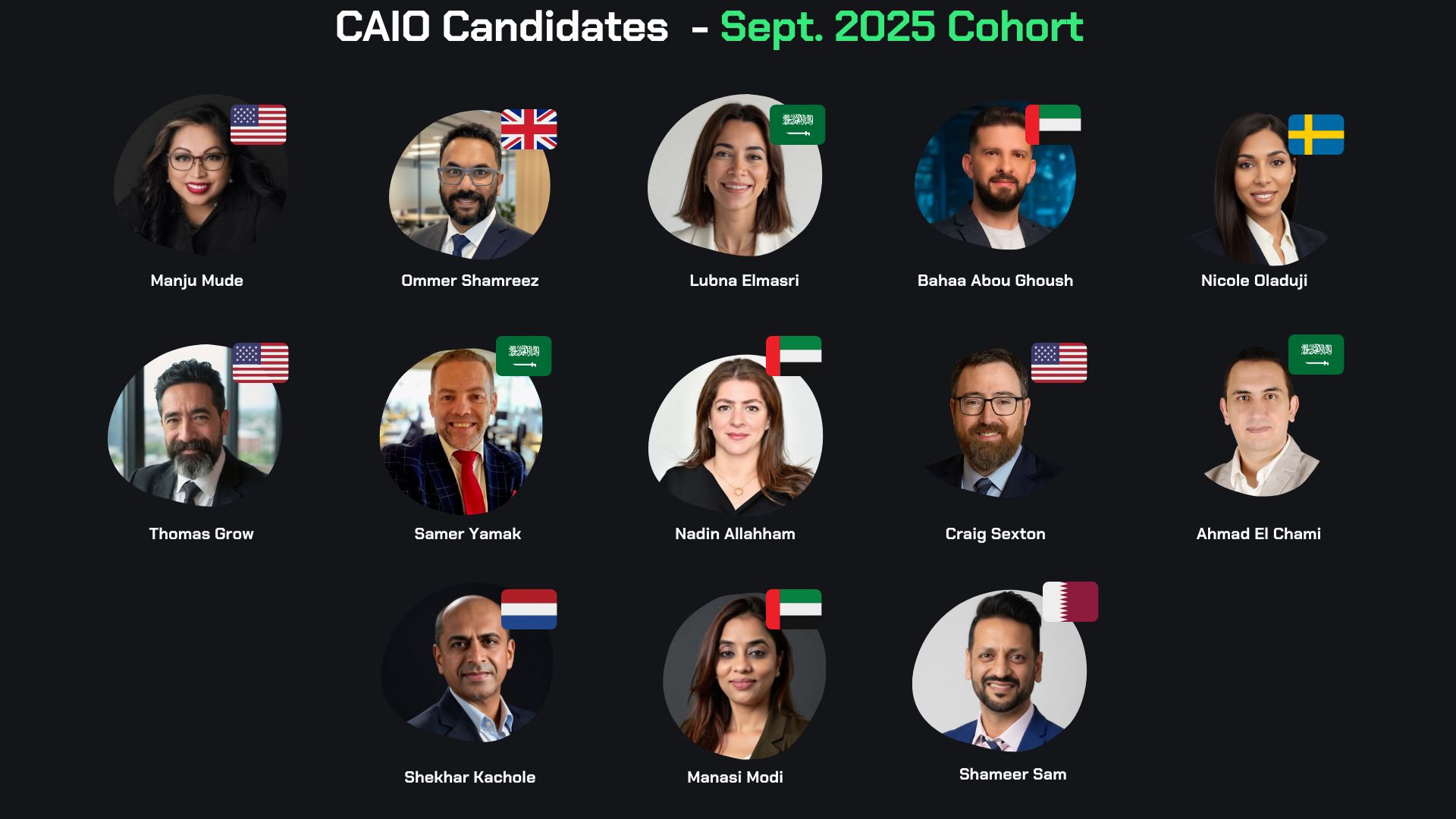- The CAIO Hub
- Posts
- The 7 AI Shifts That Will Define 2026
The 7 AI Shifts That Will Define 2026
The essential 2026 AI trends every executive needs to act on now

If you’re running strategy, building next year’s roadmap, or leading any transformation effort, 2026 is the year where AI stops being an experiment and becomes an operating reality. Budgets are tightening, regulators are waking up, competitors are moving faster than ever, and the technology stack beneath your entire business is changing shape.
Most importantly: the companies that win in 2026 will be the ones that move early, pick the right lanes, and build deliberately—not the ones chasing hype.
After analyzing global reports from Gartner, Forrester, Deloitte, IDC, and examining market signals from AI-native companies, here are the 7 AI trends that matter most for the year ahead.
Treat this as your executive compass.
1. AI Regulation Gets Teeth
Compliance becomes a launch requirement, not a checkbox.
Regulators are no longer admiring the problem—they’re enforcing it.
Europe’s AI Act enters active enforcement phases. U.S. states are rolling out AI bills with hard penalties. Financial, healthcare, and public-sector regulators are starting to demand auditable AI systems with real controls. This means:
You cannot deploy AI without eval packs, model cards, risk profiles, and bias tests.
Customers will demand audit trails and incident response plans before signing a contract.
Vendors that can’t prove safety, fairness, or control will simply be disqualified.
The opportunity:
Companies that master AI governance will win trust and unlock big-ticket deals others can’t touch.
2. Agentic AI Becomes the New Workforce
Autonomous agents move from neat demos to everyday operations.
Gartner expects almost half of enterprise applications to include agentic capabilities by 2026.
Deloitte and IDC point to the same direction: the shift from chat assistants to autonomous “co-workers.”
What this looks like in practice:
AI agents taking over multi-step workstreams—research, analysis, planning, execution.
Multi-agent systems collaborating like digital teams.
Agents working for minutes or hours per task, not seconds.
The implication:
This forces a redesign of workflows, roles, access rights, approvals, telemetry, and governance.
The exec question:
“Where in our business can agents generate 10x impact—and who will manage them?”
3. Vertical & Domain-Specific AI Takes Over
The era of generic LLMs is ending; industry AI stacks are rising.
By 2026, the competitive edge comes from AI tuned deeply to your industry:
Healthcare: clinical safety, ICD coding, diagnosis pathways
Financial services: risk controls, compliance automation, portfolio logic
Manufacturing: quality control, predictive maintenance, robotics integration
Gartner calls this DSLMs—Domain-Specific Language Models.
Why this matters:
Vertical AI solutions outperform general models on accuracy, compliance, and context.
They come with built-in guardrails tailored to your industry.
They are much harder for competitors to copy.
The play:
Own the workflows no one else understands—before a startup does it for you.
4. Hybrid & On-Device AI Reshapes Architecture
Local LLMs + cloud LLMs = the new enterprise stack.
NPU laptops, AI phones, and sovereign infrastructure are hitting the market at scale.
This means computation is shifting closer to the user:
Sensitive tasks run locally (privacy, speed, control).
Heavy reasoning runs in the cloud (intelligence, larger models).
Users will soon have always-on personal agents living on their devices.
For enterprise leaders, this introduces:
Data privacy advantages
Lower cloud costs
New product capabilities
New compliance and architecture choices
The strategic shift:
Stop assuming AI = cloud.
Start designing hybrid-first, privacy-first systems.
5. Hard-ROI AI: Outcome-Based Pricing Dominates
CFOs finally have leverage—and they’re using it.
The economy is tightening. Boards want measurable value. Vendors are under pressure.
This is the year AI must prove it works.
Expect:
Pricing tied to outcomes, not seats
AI projects judged by baseline metrics
Telemetry baked into every workflow
Clear before/after proof for every agent deployed
Multi-model architectures to arbitrage cost and performance
If your AI doesn’t show:
• hours saved
• revenue gained
• errors reduced
• risk minimized
…it won’t survive the 2026 budget cycle.
6. AI-Native Organizations Outrun Everyone Else
Small, AI-fluent teams outperform large legacy groups.
AI-native startups are hitting $1M ARR in months, shipping 10x faster, and operating with 80% fewer people.
Enterprises cannot compete with old structures.
The winners will:
Build internal AI-native squads
Upskill 10–20% of staff to AI expert operator level
Redesign roles around human + agent teams
Introduce AI leadership, AI literacy, and AI governance training
Shift from “departments” to AI-augmented workflows
This is an operating model shift:
You’re not adding tools—you’re rewiring how work happens.
A small elite gets “AI Ferraris”; everyone else gets “AI scooters.”
By mid-2026, the AI market splits into two realities:
Premium AI (top 1–5% of organizations):
$100–$300/mo per person
Access to the most capable models
Agents that can run for hours
Ability to “duplicate” people and run multiple parallel workstreams
Commodity AI (95% of companies):
Free or $20/mo
Lightweight assistants
Limited autonomy
Great adoption, but low transformation impact
This creates a competitive divide:
If your top 10–20% talent runs on premium AI, they will outperform the entire rest of the market.
If they don’t, they will be outpaced by rivals who do.
What This Means for Every Executive Planning 2026
Here are the questions that matter:
1. Regulation & Risk: Are we compliant enough to operate and scale safely?
2. Agents: Where can autonomous agents generate 10x value in our organization?
3. Vertical AI: Which industry workflows do we need to own before competitors automate them?
4. Architecture: Are we ready for hybrid local + cloud AI?
5. ROI: Can we prove the business value of every AI project?
6. Talent: Do we have AI-native teams or just traditional teams using AI?
7. Platform Strategy: Will we empower our people with premium AI or settle for commodity tools?
Final Word: 2026 Belongs to the Prepared
The gap between leaders and laggards will widen faster than any previous tech cycle.
This is not about hype—it’s about execution.
You don’t need to do everything.
But you must choose your lane and commit.
If you get governance, agents, vertical focus, architecture, talent, and ROI right, 2026 becomes your competitive breakout year.
If you delay, you’ll spend 2027 trying to catch up.

Sam Obeidat is a senior AI strategist, venture builder, and product leader with over 15 years of global experience. He has led AI transformations across 40+ organizations in 12+ sectors, including defense, aerospace, finance, healthcare, and government. As President of World AI X Ventures, a global corporate venture studio, Sam works with top executives and domain experts to co-develop high-impact AI use cases, validate them with host partners, and pilot them with investor backing—turning bold ideas into scalable ventures. Under his leadership, World AI X has launched ventures now valued at over $100 million, spanning sectors like defense tech, hedge funds, and education. Sam combines deep technical fluency with real-world execution. He’s built enterprise-grade AI systems from the ground up and developed proprietary frameworks that trigger KPIs, reduce costs, unlock revenue, and turn traditional organizations into AI-native leaders. He’s also the host of the Chief AI Officer (CAIO) Program, an executive training initiative empowering leaders to drive responsible AI transformation at scale.
Contact at [email protected]
Sponsored by World AI X
The CAIO Program
Preparing Executives to Shape the Future of their Industries and Organizations
World AI X is excited to extend a special invitation for executives and visionary leaders to join our Chief AI Officer (CAIO) program! This is a unique opportunity to become a future AI leader or a CAIO in your field.
During a transformative, live 6-week journey, you'll participate in a hands-on simulation to develop a detailed AI strategy or project plan tailored to a specific use case of your choice. You'll receive personalized training and coaching from the top industry experts who have successfully led AI transformations in your field. They will guide you through the process and share valuable insights to help you achieve success.
By enrolling in the program, candidates can attend any of the upcoming cohorts over the next 12 months, allowing multiple opportunities for learning and growth.
We’d love to help you take this next step in your career.
About The AI CAIO Hub - by World AI X
The CAIO Hub is an exclusive space designed for executives from all sectors to stay ahead in the rapidly evolving AI landscape. It serves as a central repository for high-value resources, including industry reports, expert insights, cutting-edge research, and best practices across 12+ sectors. Whether you’re looking for strategic frameworks, implementation guides, or real-world AI success stories, this hub is your go-to destination for staying informed and making data-driven decisions.
Beyond resources, The CAIO Hub is a dynamic community, providing direct access to program updates, key announcements, and curated discussions. It’s where AI leaders can connect, share knowledge, and gain exclusive access to private content that isn’t available elsewhere. From emerging AI trends to regulatory shifts and transformative use cases, this hub ensures you’re always at the forefront of AI innovation.
For advertising inquiries, feedback, or suggestions, please reach out to us at [email protected].

Reply